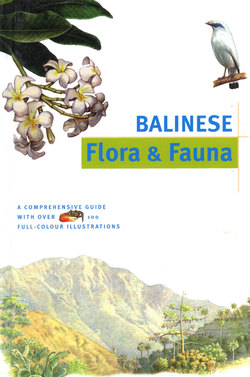Читать книгу Balinese Flora & Fauna Discover Indonesia - Bruce Granquist - Страница 5
На сайте Литреса книга снята с продажи.
ОглавлениеBali's Biogeography
Bali is a relatively 'young' island, having probably first emerged above the waves some 3 million years ago. It is one of the most volcanically active islands in the world and volcanoes have played an important role in shaping the natural history of Bali. Periodic eruptions spew forth great streams of molten balsatic lava which, when they have cooled, are broken down by natural erosion to form a fertile sediment in the valleys and plains. These rich soils supported the great swathe of forest that once covered most of the island and which can still be found in the west.
In historical times, much of this forest cover has been lost to agriculture, the natural fertility of the island allowing the cultivation of two rice crops a year to feed an ever-growing human population, which today stands at roughly 3 million.
Island Biogeography
Bali is a so-called continental island, that is to say, an island which sits on the continental shelf and is typically situated close to the mainland, in this case Java. Surrounded by shallow seas, it is periodically connected to the mainland at times of lowered sea levels which occur whenever there are ice ages. The latter circumstances allow an exchange of species—both plant and animal— with the mainland, with the result that the native flora and fauna of the island generally resembles that of the mainland, though the diversity of island species is usually less.
Bali is no exception to this rule, though the island does have at least one known endemic species, that is to say, a species which is unique to Bali and found nowhere else in the world. This is the famed Bali starling (Lucospar rothschildi) which was only discovered by Western science as recently as 1911. In the past, there was also a subspecies of tiger (Panthera tigris balica), but that has become extinct, a fate which also threatens the Bali starling.
Plate Tectonics
The Earth's surface is made up of gigantic rocky 'plates', which can be up to 100 kilometres thick. These plates are not 'fixed', but rest on more fluid layers beneath which allow them to move about, giving rise to the phenomenon known as continental drift. Some 25 0 kilometres off the southern coast of Bali there is a very deep fault in the ocean floor known as the Java Trench. South of this lies the Indo-Australian plate which is moving northwards, crunching up against and sliding under the Sunda Plate on which Bali and the rest of Southeast Asia sits. As the Indo-Australian Plate dips under the Sunda Plate along the line of the Java Trench, periodic earthquakes occur, occasioned by sudden slippages between the two plates. At the same time, heat generated by the friction of these massive plates moving against each other causes pockets of molten rock to form under high pressure, and where these escape to the surface, they give rise to volcanoes.
Man and the Environment
The Balinese are an Austronesian people who share a common historical and cultural background with the other peoples of the region. It seems likely that the original homeland of the Austronesians was Taiwan, but some 6,000 years ago this ancestral population began to disperse, migrating southwards through the Philippines before turning eastwards into the Pacific and west towards the islands of Indonesia. This movement of people was not a mass exodus, but probably consisted of small groups of related kin, travelling by outrigger canoe who, over the course of several millennia, island-hopped their way across both the Pacific and Indian Oceans to constitute the world's most widely dispersed language group prior to the modern era
Bali was probably settled some 3 to 4 thousand years ago by people who were farmers and
herders, and who brought with them a bronze- and possibly iron-age technology. In the course of time, the human population has had a considerable impact on the natural history of the island, most notably in terms of deforestation and species extinction.
The most populated region has for centuries been the coastal plains and fertile valleys to the south of the central mountain range. It is here that the work of man is most evident in the form of the remarkable terraced rice fields which have been sculpted by hand from the natural contours of the land.
Rainfall and Climate Patterns
Climate plays a critical role in habitat formation and the dry southeast monsoon winds from Australia, which blow during the middle of the year, have an important influence on the type of vegetation found in the northeastern part of the island where lowland forest gives way to savanna grasslands.
Rainfall is also a crucial factor affecting vegetation types and growth patterns. On Bali, there are distinct seasonal variations, the wettest months of the year being between October and March.
El Nino
The so-called 'El Nino effect', which has received much attention in recent years, is caused by a huge pool of warm water, some 200 metres deep, in the Pacific Ocean, which oscillates in an irregular manner between Indonesia and the eastern Pacific. The warm phase of El Nino results in an extended, drier-than-normal dry season, with associated droughts, reduced rice harvests and forest fires, the worst example of this in recent years being the dry season of 1997.
